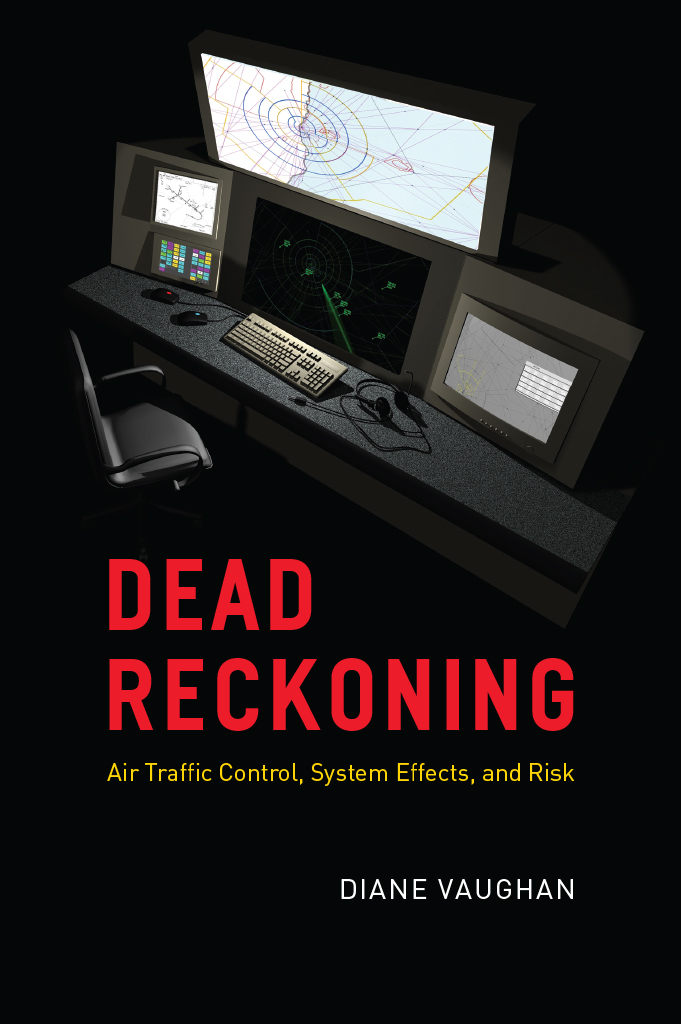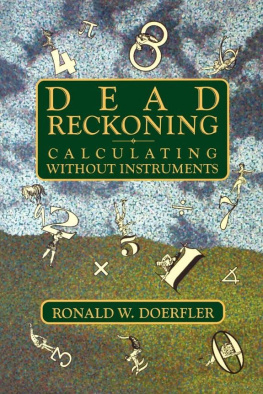Diane Vaughan - Dead Reckoning: Air Traffic Control, System Effects, and Risk
Here you can read online Diane Vaughan - Dead Reckoning: Air Traffic Control, System Effects, and Risk full text of the book (entire story) in english for free. Download pdf and epub, get meaning, cover and reviews about this ebook. year: 2021, publisher: University of Chicago Press, genre: Politics. Description of the work, (preface) as well as reviews are available. Best literature library LitArk.com created for fans of good reading and offers a wide selection of genres:
Romance novel
Science fiction
Adventure
Detective
Science
History
Home and family
Prose
Art
Politics
Computer
Non-fiction
Religion
Business
Children
Humor
Choose a favorite category and find really read worthwhile books. Enjoy immersion in the world of imagination, feel the emotions of the characters or learn something new for yourself, make an fascinating discovery.
- Book:Dead Reckoning: Air Traffic Control, System Effects, and Risk
- Author:
- Publisher:University of Chicago Press
- Genre:
- Year:2021
- Rating:4 / 5
- Favourites:Add to favourites
- Your mark:
- 80
- 1
- 2
- 3
- 4
- 5
Dead Reckoning: Air Traffic Control, System Effects, and Risk: summary, description and annotation
We offer to read an annotation, description, summary or preface (depends on what the author of the book "Dead Reckoning: Air Traffic Control, System Effects, and Risk" wrote himself). If you haven't found the necessary information about the book — write in the comments, we will try to find it.
Diane Vaughan: author's other books
Who wrote Dead Reckoning: Air Traffic Control, System Effects, and Risk? Find out the surname, the name of the author of the book and a list of all author's works by series.
Dead Reckoning: Air Traffic Control, System Effects, and Risk — read online for free the complete book (whole text) full work
Below is the text of the book, divided by pages. System saving the place of the last page read, allows you to conveniently read the book "Dead Reckoning: Air Traffic Control, System Effects, and Risk" online for free, without having to search again every time where you left off. Put a bookmark, and you can go to the page where you finished reading at any time.
Font size:
Interval:
Bookmark:

Diane Vaughan
The University of Chicago Press
CHICAGO & LONDON
The University of Chicago Press, Chicago 60637
The University of Chicago Press, Ltd., London
2021 by The University of Chicago
All rights reserved. No part of this book may be used or reproduced in any manner whatsoever without written permission, except in the case of brief quotations in critical articles and reviews. For more information, contact the University of Chicago Press, 1427 E. 60th St., Chicago, IL 60637.
Published 2021
Printed in the United States of America
30 29 28 27 26 25 24 23 22 21 1 2 3 4 5
ISBN-13: 978-0-226-79640-6 (cloth)
ISBN-13: 978-0-226-79654-3 (e-book)
DOI: https://doi.org/10.7208/chicago/9780226796543.001.0001
Library of Congress Cataloging-in-Publication Data
Names: Vaughan, Diane, author.
Title: Dead reckoning : air traffic control, system effects, and risk / Diane Vaughan.
Description: Chicago : University of Chicago Press, 2021. | Includes bibliographical references and index.
Identifiers: LCCN 2020056565 | ISBN 9780226796406 (cloth) | ISBN 9780226796543 (ebook)
Subjects: LCSH: Air traffic control. | Air traffic controllers.
Classification: LCC TL725.3.T7 V384 2021 | DDC 387.7/404260973dc23
LC record available at https://lccn.loc.gov/2020056565
 This paper meets the requirements of ANSI/NISO Z39.48-1992 (Permanence of Paper).
This paper meets the requirements of ANSI/NISO Z39.48-1992 (Permanence of Paper).
For my support team that has endured
through all the books,
all the events, over the years,
my dearest loves,
my very best work,
my children
The Wright brothers first flight on December 17, 1903, at Kitty Hawk, North Carolina
Archie League, first air traffic controller, with signal flags and wheelbarrow, Lambert Municipal Field, St. Louis, Missouri, 1929
Beacon, steel tower, shed, and concrete directional arrow, beginning Transcontinental Air Mail Route, 1925
Archie League with signaling light, Lambert Municipal Field, St. Louis, Missouri, 1933
Air traffic controller in radio-equipped tower connecting to airline dispatchers, Newark, New Jersey, 1936
Controllers using blackboards, maps, and phones to airline dispatchers to sequence en route traffic between airports, Newark Airway Traffic Control Station, 1936
Sequencing en route traffic with compasses and moving shrimp boats on table maps, Newark Airway Traffic Control Station, 1936
Women controllers, who replaced men during the war, sequencing en route traffic with flight progress strips, replacing blackboards, early 1940s
Radar arriving and controller following blips on upright screen, Washington Air Route Traffic Control Center, 1948
Controllers using flight progress strips to sequence en route traffic and move shrimp boats on flat radar, Washington Air Route Traffic Control Center, 1955
Flight progress strip
Facility architectural layouts, 2000
Boston Center architectural layout, control room, 1990
Boston Center architectural layout, control room, 2000
Flight progress strip with controller markings
Bedford Tower architectural layout with positions, 2000
Bedford Tower pad management system
Bedford Tower airport diagram
Boston Tower airport diagram
DallasFort Worth airport diagram
Boston TRACON architectural layout with positions, 2000
Boston Tower architectural layout with positions, 2000
Arrival-departure window/Converging Runway Display Aid
Boston TRACON control room, Merrimack, New Hampshire, 2004
Boston TRACON control room architectural layout, Merrimack, New Hampshire, 2004
Boston TRACON control room inner circle redesign, Merrimack, New Hampshire, 2017
Responses of air traffic controllers to whether the job has fundamentally changed them as a person
Extent of the fundamental change experienced by air traffic controllers
Reckoning, according to the dictionary, is a cognitive activity: an act or instance of taking into account, calculating, estimating. Dead reckoning is a navigational term that has these cognitive processes at its core. It refers to a procedure that attempts to locate something in space or time by deductionthat is, unaided by direct observation or direct evidenceand thus the original term, ded reckoning. The historical origin of dead reckoning is in early marine navigation. Unable to identify their location by direct observation or in relation to familiar landmarks, early mariners developed methods of observing and recording their position, distances and directions traveled, and currents of wind and water. The purpose was to calculate where their vessel was, to compare progress with a predetermined route, and to correct for any deviations. For many centuries, navigators relied on the positions and motions of sun and stars and direction of winds for their direction finding. The calculative, intuitive, and cognitive aspects of dead reckoning dominated navigational practice; material technologies were absent.
But gradually, the cognitive and the technological began to merge in navigation. Marine charts, maps, the compass, and devices for measuring speed and distance were among the earliest material technologies for sea navigation. They enabled navigators not only to plot where a craft was but also to predict where it would be at given time. But technological advance notwithstanding, mistake was endemic, due to calculation errors based on using these early devices. With the invention of the airplane in the early twentieth century, human cognition and material technologies have merged in both air and sea navigation, the changes driven by the continuing assumption that increasing the sophistication of the technology will improve the accuracy of measurement and prediction, reduce mistakes, and therefore increase safety.
Now, in the twenty-first century, dead reckoning has even broader meaning. The amount of traffic, the amount and complexity of the technology, and the institutional and organizational contexts of navigation have changed dramatically. So have the goals: dead reckoning includes not only selection of the course, staying on it, and avoiding collision but also mandates to achieve cost efficiency by minimizing fuel consumption and adhering to a predetermined schedule. Moreover, dead reckoning occurs at the organizational and system levels, as administrators estimate and calculate in order to track, predict, and be responsive to changing demands and resources. Counting and measurement dominate, as science and technology are deployed in the interest of accuracy, safety, and efficiency, as well as the survival of the organizational system itself.
This book explores dead reckoning in air traffic control in the early twenty-first century. The central puzzle is, what makes air traffic control so safe? Although the Federal Aviation Administration (FAA), the agency responsible for regulating air traffic in the United States, has been repeatedly castigated by Congress and the press for inefficiencies, costly technologies, congestion, and delays, the FAAs air traffic control system, responsible for the management of airplane movement on the ground and in the sky, nonetheless has a surprisingly positive safety record. Failures, in the form of accidents and collisions for commercial airlines, are a rarity. When these occur, most often they are due to pilot error or technical failure. In contrast to commercial airlines, accidents are frequent in general aviation, where pilots are not typically trained to be professional pilots, are less experienced, and fly in uncontrolled airspace. However, the safety record of air traffic control for commercial aviation is impressive.
Next pageFont size:
Interval:
Bookmark:
Similar books «Dead Reckoning: Air Traffic Control, System Effects, and Risk»
Look at similar books to Dead Reckoning: Air Traffic Control, System Effects, and Risk. We have selected literature similar in name and meaning in the hope of providing readers with more options to find new, interesting, not yet read works.
Discussion, reviews of the book Dead Reckoning: Air Traffic Control, System Effects, and Risk and just readers' own opinions. Leave your comments, write what you think about the work, its meaning or the main characters. Specify what exactly you liked and what you didn't like, and why you think so.











